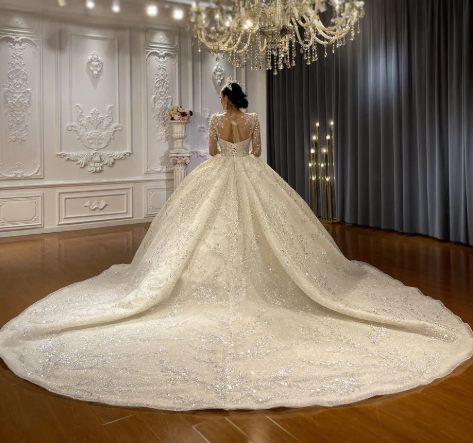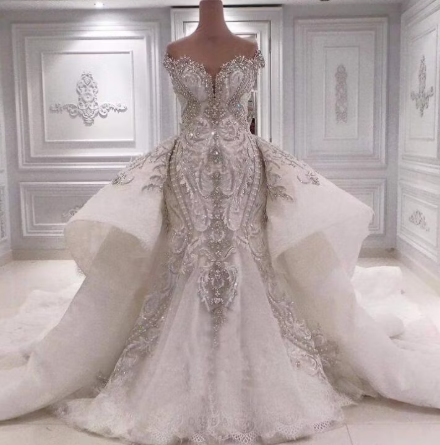
For many brides, the wedding day is more than a single outfit moment. It often begins with the walk down the aisle in a carefully chosen gown and flows into an evening of celebration where comfort and movement take center stage.
That’s exactly why some brides now opt for two looks: a statement ceremony gown and a second dress for the reception.
If you’re considering this approach, understanding the basics of gown design will help you make the right choices. From exploring luxury bridal gowns for the vows to selecting an evening look that complements them, this guide explores what you need to look for and how you can create harmony between both.
Anatomy of a Gown: The Basics Every Bride Should Know
Choosing wedding and reception looks becomes much easier when you understand the structure of a gown. While styles vary widely, most designs are defined by a few key elements:
Silhouette
The silhouette refers to the overall outline of the gown. Choosing the right one sets the stage for how the rest of the gown is perceived.
Common types include:
Ball gown
Mermaid
Sheath
A-line
Each silhouette creates a distinct effect. Ball gowns emphasize grandeur, mermaids highlight curves, and sheaths offer minimalist elegance.
Neckline
The neckline frames the face and shoulders, often drawing attention upward. From the romantic sweetheart style to the dramatic off-shoulder and the modest high neck, this dress element can influence both the style and comfort. It also helps balance proportions, especially when paired thoughtfully with jewelry.
Sleeves and Straps
Sleeves range from barely-there straps to full-length, fitted designs. They can soften a look, add coverage, or contribute drama (think puffed sleeves or delicate lace overlays).
Brides and eveningwear fashionistas also use sleeves to adapt gowns for seasonal appropriateness or to reflect personal modesty preferences.
Bodice
The bodice is the upper portion of a gown, extending from the neckline to the waist. It defines the fit and provides structure, whether through corsetry, boning, or softer tailoring. A well-fitted bodice shapes the torso and acts as the foundation for embellishments such as lace overlays, beadwork, or embroidery.
Fabric and Embellishments
Satin, lace, chiffon, and beadwork each carry their own weight, texture, and mood. These choices can tie your ceremony gown and evening dress together in subtle, elegant ways.
Hemline
The hemline is where the dress ends, which can dramatically alter its mood.
Floor-length gowns create formality, while tea-length or asymmetrical hemlines feel lighter and more playful. Trains (i.e., extensions of the hemline) are particularly popular in bridal gowns for their regal flair, though many opt for detachable designs for practicality.
Skirt
The skirt forms the lower half of the gown, flowing from the waistline to the hem. Its cut determines the overall silhouette (imagine the difference between full ball gowns and sleek sheath dresses).
Volume, layering, and fabric choice all influence the skirt’s character, making it one of the most defining elements of a bridal or evening look.
Key Considerations When Choosing Your Gown

Once you’re familiar with gown anatomy, the next step is making decisions that align with your needs and vision. Beyond visual appeal, a few practical and personal considerations can make the difference between a gown that looks good and one that feels unforgettable.
1. Body Shape and Proportions
Not every silhouette flatters every figure in the same way. An A-line dress, for example, is a versatile option that balances most body shapes, while mermaid gowns emphasize curves.
Understanding how proportions work helps ensure confidence in both the ceremony and reception attire. For instance, petite brides may opt for streamlined sheaths to elongate the frame, while taller brides can easily pull off voluminous skirts.
2. Fabric and Setting
Fabric sets the tone of a gown and affects how it moves throughout the day. Some materials naturally pair with certain styles:
Silk satin drapes beautifully on minimalist gowns.
Lace lends texture to romantic designs.
Tulle creates volume for fuller skirts.
Structured fabrics like Mikado or Duchesse satin are ideal for dramatic silhouettes.
Season and setting are also equally important. Lightweight options such as chiffon or crepe work well in warm climates, while heavier textiles like satin or faille suit cooler weather and more formal settings.
Choosing fabrics with both style and practicality in mind ensures comfort without sacrificing elegance.
3. Detailing and Embellishment
Ornamentation is often what transforms a simple gown into a statement. Beadwork, lace appliqués, embroidery, and sequins each create a unique mood, but they should never overpower the overall design.
Brides often choose intricate detailing for the ceremony gown and opt for something subtler in the evening dress to allow ease of wear and avoid competing looks.
4. Personalization and Modesty
Customization is key in making a gown feel like your own. Neckline adjustments, sleeve additions, or detachable overskirts can adapt a dress to fit cultural expectations, religious requirements, or simply your comfort level.
Personal touches, through tailoring, accessories, or layered details, ensure your bridal and evening outfits reflect who you are while maintaining harmony between both.
Bridal and Evening Looks: How to Achieve Harmony
Changing from a bridal gown into an evening dress is all about ushering a smooth flow between two important moments.
The easiest way to achieve this is by carrying through a detail that ties the outfits together. It could be a fabric choice, a neckline style, or even a recurring motif like lace or embroidery. A ceremony gown with intricate beading, for example, can transition seamlessly into a sleeker evening dress that features the same embellishment in a lighter touch.
Balance also matters. A voluminous ball gown ceremony outfit works well with a slim silhouette, offering contrast without looking mismatched. Accessories can also act as connectors. Statement earrings, a belt, or a hairpiece styled differently for each look help unify the overall aesthetic.
Cultural preferences should also guide the transition. In the United Arab Emirates (UAE), many brides favor modest silhouettes for the ceremony, later choosing an evening dress that allows more movement while still maintaining elegance.
Whatever the choice, harmony comes from thoughtful links (through design, accessories, or styling) that make the change feel intentional.
A Seamless Style Journey
Wedding days are filled with moments that deserve their own spotlight, and your outfits should rise to each occasion. Learn the basics, consider practical details, and pair your bridal and evening looks with intention. The outcome is a cohesive style story that feels effortless yet unforgettable.









(0) comments
We welcome your comments
Log In
Post a comment as Guest
Keep it Clean. Please avoid obscene, vulgar, lewd, racist or sexually-oriented language.
PLEASE TURN OFF YOUR CAPS LOCK.
Don't Threaten. Threats of harming another person will not be tolerated.
Be Truthful. Don't knowingly lie about anyone or anything.
Be Nice. No racism, sexism or any sort of -ism that is degrading to another person.
Be Proactive. Use the 'Report' link on each comment to let us know of abusive posts.
Share with Us. We'd love to hear eyewitness accounts, the history behind an article.